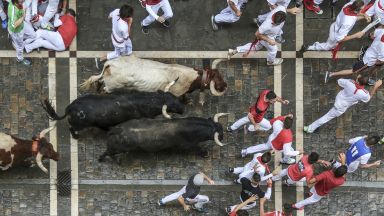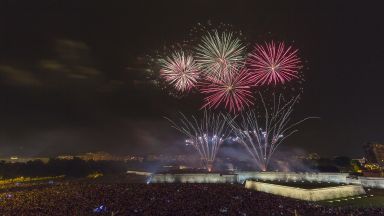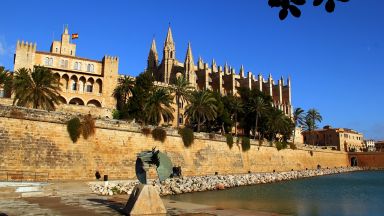Pamplona: The Complete Guide
Pamplona, the capital of Navarra, is by far the largest and most noteworthy city of the area. The city is well known for its tourists who flock to Pamplona to experience the famous Running of the Bulls event, during the San Fermín Festival in July. Pamplona owes some of its fame to its adopted son, Ernest Hemingway, who spent a considerable amount of time in Navarra during the Spanish Civil War and wrote about the San Fermín Festival and the “Running of the Bulls” (“Encierro” in Spanish) in his book, “The Sun Also Rises.”
However Pamplona has much more to offer with its medieval walls and architectural gems like its Gothic cathedral, 16th-century citadel, and Baroque town hall. The Old Town’s quaint, narrow streets and spacious squares, where locals gather to socialize with friends and family, have an inviting ambience with many outdoor cafés.
This charming historic town was founded by Pompey in 75-74BC, while he was fighting the against Quintus Sertorius, the leader of a revolt against Rome. The city’s first name was Pompeiopolis or Pompaelo – the city of Pompey. In the 5th century, the Visigoths establish a bishopric here and called the city Iruña. It fell and was occupied by the Moors in 711. In 778, Charlemagne razed the walls of Pamplona, which lead to Basque forcing him to retreat at the Battle of Roncesvalles, an event interpreted as the beginnings of the small Kingdom of Pamplona. Its first king was Eneko Aritza. Pamplona was made capital of the kingdom of Navarre by Sancho III of Navarre (1000–35), and his new foundation was known as the Ciudad de la Navarrería. In 1512 the armies of King Ferdinand of Aragon-Castile entered Pamplona, and the portion of Navarre south of the Pyrenees was incorporated into Spain. The citadel built by Philip II of Spain in 1571 made Pamplona the most strongly fortified town of the north. After the First Carlist War (1833–39), Pamplona ceased (1841) to be the capital of the Navarre kingdom but became capital of the new Navarra province.
The medieval configuration of Pamplona was made up of three neighbourhoods: the town of San Cernin, the city of Navarrería and the town of San Nicolás with each borough having its own walls. Around the year 1000AD Pamplona population was on a decline and its population the City of Navarrería was concentrated around the current Cathedral. The origins of the borough of San Cernin date back to the end of the 11th century, to the episcopate of Don Pedro de Roda, when people from France , from Cahors – says the Chronicle of the Prince of Viana – settled and built their homes in the flat area located between the episcopal city, formed around the cathedral – the city of Navarrería – and the open countryside to the west. It had its own church built according to French fashion and with a Provençal invocation, Saint Cernin, like Saint-Sernin de Tolouse (France) – Iglesia de San Saturnino. The town of San Nicolás was built adjacent to the borough of San Cernin with the church of San Nicolás as a defensive bulwark, not only against possible external aggression from the plains, but also from the town of San Cernin. Carlos III decides to cut the problem at its roots and on September 8, 1423 dictates the Privilege of the Union, in which the three jurisdictions are united in a single town hall, with a single shield and a single income.
Visiting Pamplona for the first time and wondering what are the top places to see in the city? In this complete guide, I share the best things to do in Pamplona on the first visit. Top help you plan your trip, I have also included an interactive map and practical tips for visiting!
This website uses affiliate links which earn a small commission at no additional cost to you.
20 Best places to See in Pamplona
This complete guide to Pamplona not only tells you about the very best sights and tourist attractions for first-time visitors to the city but also provide insights into a few of our personal favorite things to do.
This is a practical guide to visiting the best places to see in Pamplona and is filled with tips and info that should answer all your questions!
Museum Of Navarre

Location: Calle Cuesta de Santo Domingo, Pamplona | Hours: 9.30am-2pm & 5-7pm Tue-Sat, 11am-2pm Sun | Price: Saturday afternoon: €1 Sunday: free entry Other days: €2 | Website | Distance: 0.30km
Visiting Museum Of Navarre
La Taconera

Visiting La Taconera
Museo Universidad de Navarra

Location: calle Cuesta de Santo Domingo 47 | Hours: 9.30am-2pm & 5-7pm Tue-Sat, 11am-2pm Sun | Website | Distance: 0.30km
Visiting Museo Universidad de Navarra
Parroquia San Lorenzo

Location: Iglesia de - San Lorenzo - Eliza, Calle Mayor, 74, 31001 Pamplona, Navarra, Spain | Distance: 0.40km
Visiting Parroquia San Lorenzo
Iglesia de San Saturnino (San Cernin)

Location: Iglesia de San Saturnino Calle San Saturnino, S/N 31001 Pamplona Navarra Spain | Price: Free | Website | Distance: 0.50km
Visiting Iglesia de San Saturnino (San Cernin)
Royal and General Archive of Navarra (Palacio de los Virreyes)

Location: Royal and General Archive of Navarra Calle Dos de Mayo, s/n 31001 Pamplona Navarra Spain | Hours: Tuesday to Friday, from 11:00 to 14:00 and from 18:00 to 20:00. Saturdays, Sundays and holidays, from 11:00 to 14:00. Closed Monday. | Distance: 0.50km
Visiting Royal and General Archive of Navarra (Palacio de los Virreyes)
San Fermín de Aldapa

Location: San Fermin De Aldapa, Calle Dos de Mayo, Pamplona, Spain | Distance: 0.50km
Visiting San Fermín de Aldapa
Ayuntamiento de Pamplona

Location: Ayuntamiento de Pamplona Plaza Consistorial, s/n 31001 Pamplona Navarra Spain | Distance: 0.50km
Visiting Ayuntamiento de Pamplona
Iglesia De San Nicolas

Visiting Iglesia De San Nicolas
Portal de Francia, Pamplona

Location: Calle Carmen, 35, 31001 Pamplona, Navarra, Spain | Hours: 24 Hours | Price: Free | Website | Distance: 0.60km
Visiting Portal de Francia, Pamplona
Catedral de Pamplona

Location: Calle Dormitalería | Hours: 10.30am-7pm Mon-Sat Apr-Oct, to 5pm Nov-Mar, tower climb 11.15am | Price: Adult/child €5/3 | Website | Distance: 0.70km
Visiting Catedral de Pamplona
Plaza del Castillo

Location: Plaza del Castillo, Pamplona | Hours: 24 Hours | Price: Free | Distance: 0.70km
Visiting Plaza del Castillo
Albergue de Jesús y María

Location: Calle Compañía, 4, Pamplona, Spain | Distance: 0.70km
Visiting Albergue de Jesús y María
Mirador de Caballo Blanco

Visiting Mirador de Caballo Blanco
Ciudadela de Pamplona

Location: Avenida del Ejército s/n 31002 Pamplona-Iruña, Pamplona, Navarre (Autonomous Community of Navarre) | Hours: 8am-9.30pm Mon-Sat, from 9am Sun | Website | Distance: 0.80km
Visiting Ciudadela de Pamplona
Palacio de Navarra

Location: 1 Avenida Carlos III El Noble, Pamplona | Hours: 08 - 14:30 Closed Sat & Sun | Website | Distance: 0.80km
Visiting Palacio de Navarra
Monumento Al Encierro

Location: Avenida de Roncesvalles | Hours: 24 Hours | Price: Free | Distance: 0.90km
Visiting Monumento Al Encierro
Plaza de Toros de Pamplona

Location: Paseo Hemingway, s/n. 31002 Pamplona - Iruña | Hours: Until July 31st: Monday to Sunday, from 10:30 a.m. to 7:00 p.m.From August 1st to 30th: Monday to Sunday, from 10:30 a.m. to 8:00 p.m. (group by reservation)From September 1st to October 31st: Monday: groups only by reservation. Tuesday to Saturday, from 10:30 a.m. to 7:30 p.m. Sundays, from 10:30 to 14:30October 12th, 10:30 a.m. to 7:30 p.m. | Website | Distance: 1.00km
Visiting Plaza de Toros de Pamplona
Magdalena Bridge (Pamplona)

Visiting Magdalena Bridge (Pamplona)
Centro De Interpretacion De Las Fortificaciones De Pamplona, Pamplona

Location: cnr Calles Arrieta & Aralar | Hours: 11am-2pm & 5-7pm Tue-Sun Apr-Oct, 10am-2pm & 4-6pm Nov-Mar | Price: adult/child €3/1.50 | Website | Distance: 1.10km
Visiting Centro De Interpretacion De Las Fortificaciones De Pamplona, Pamplona



